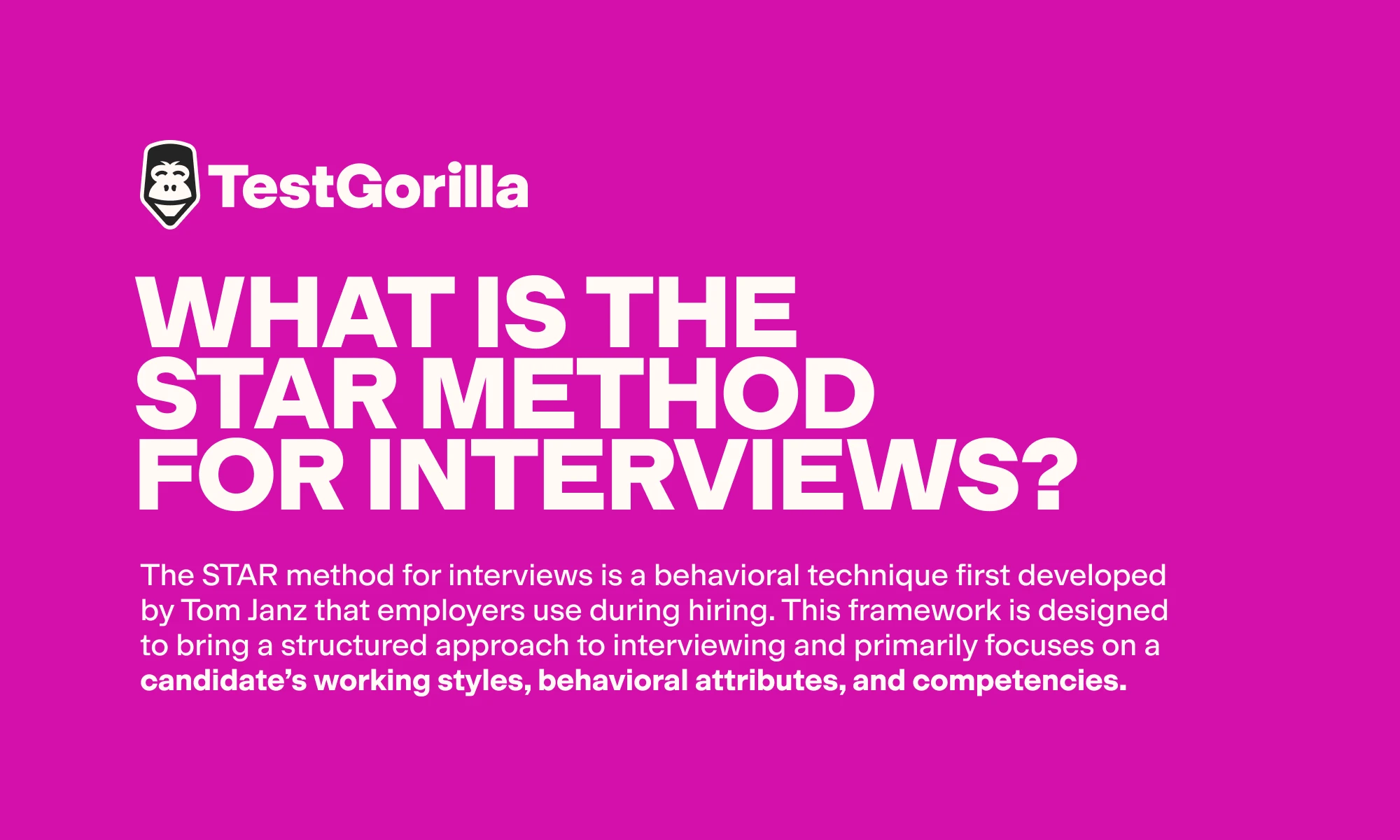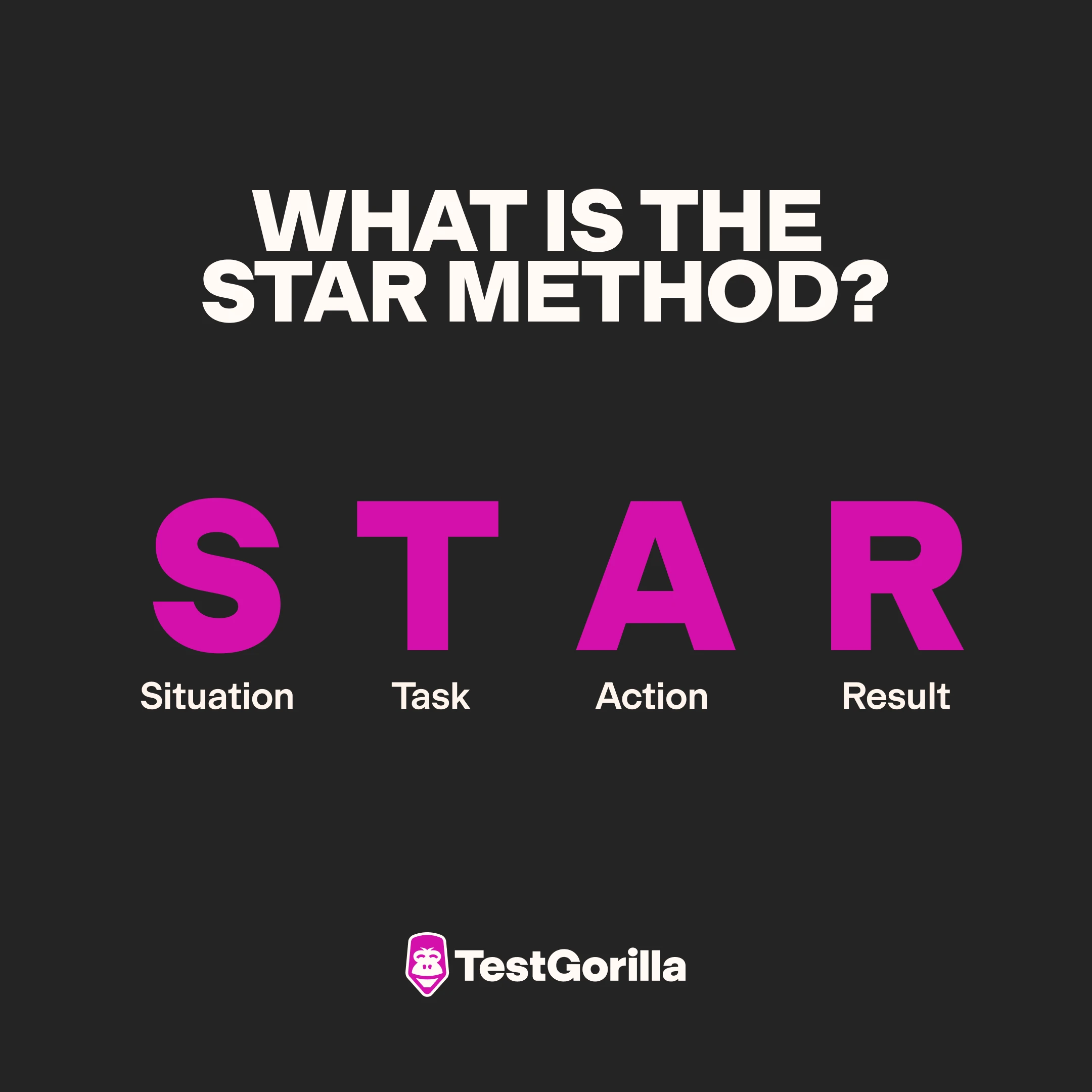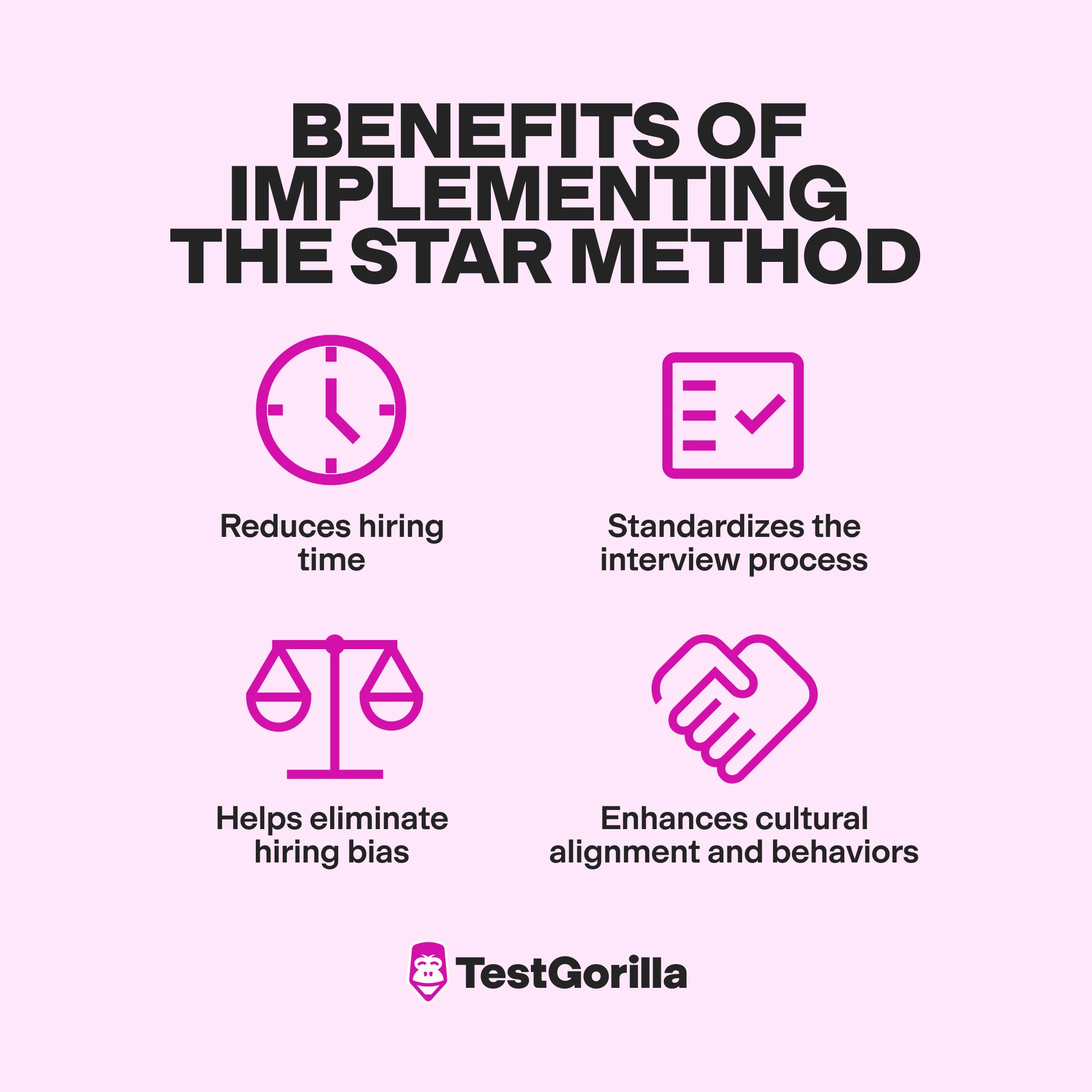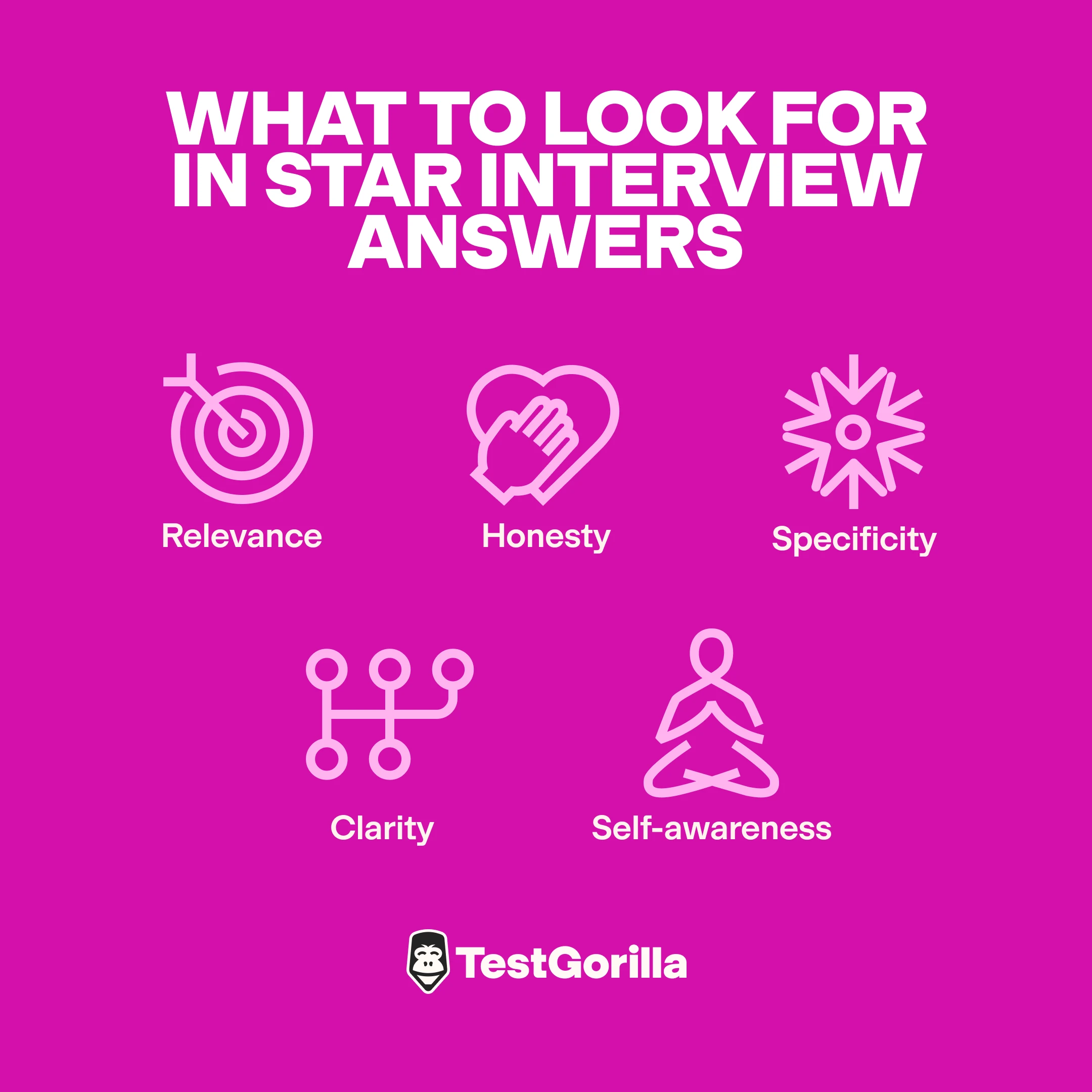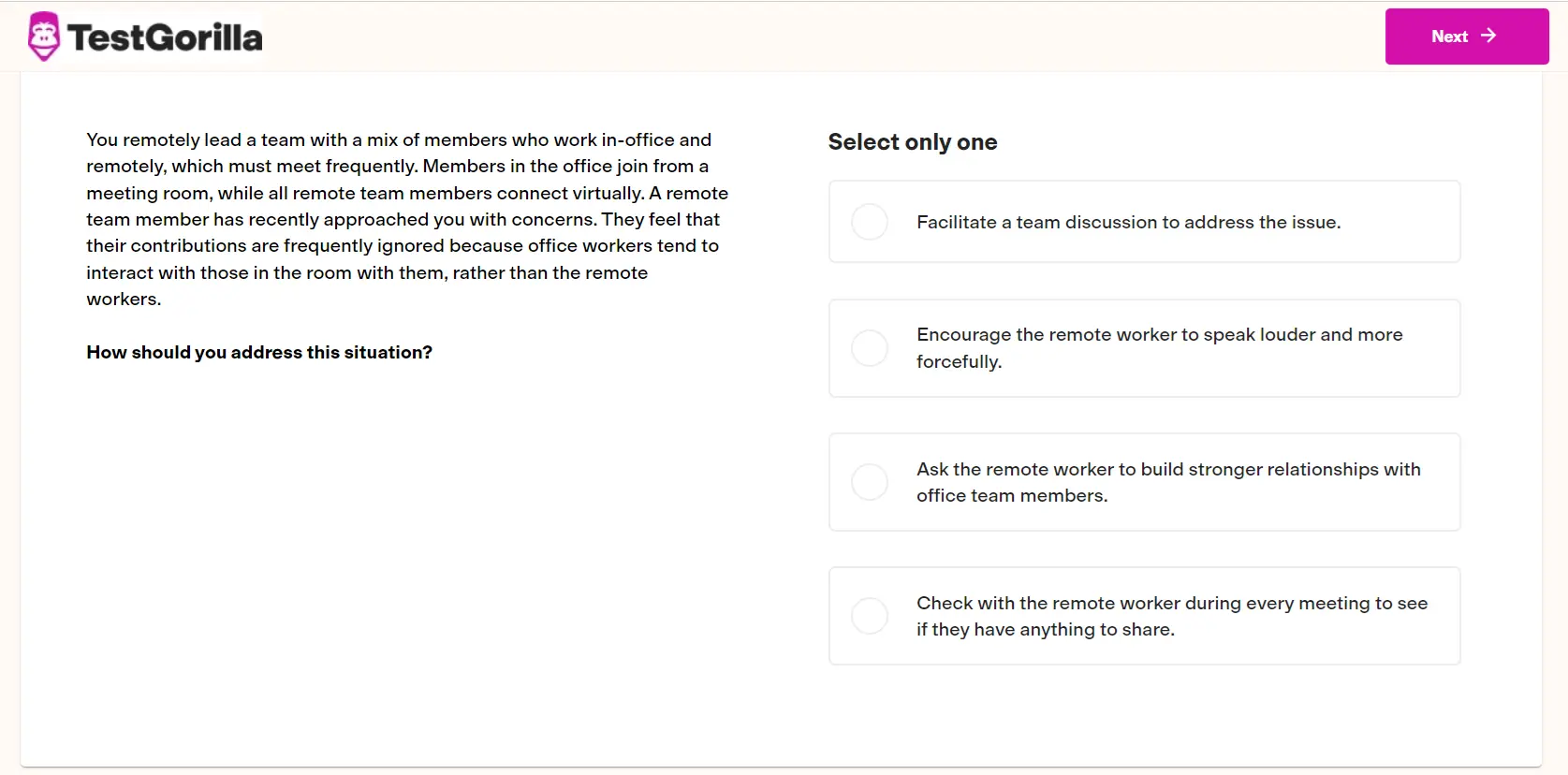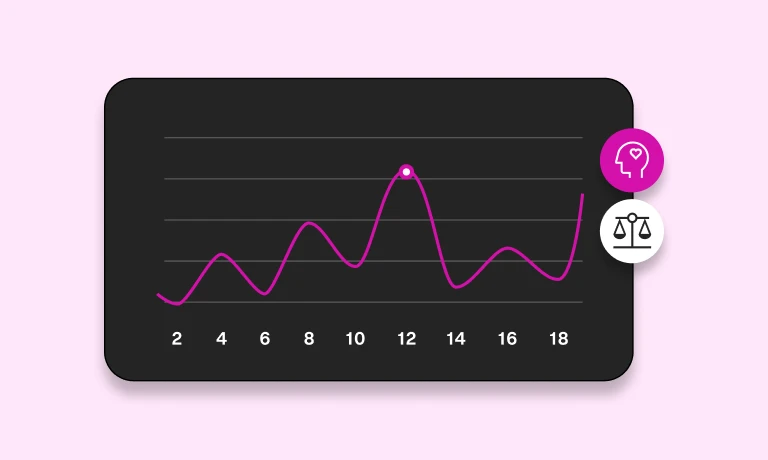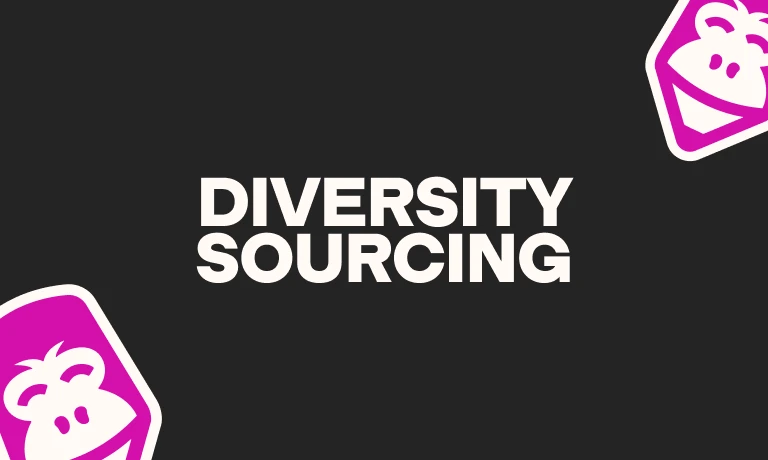How to use the STAR method for interviews
Upgrade your team — find your next great hire with TestGorilla
Many poor hiring decisions boil down to how thoroughly you screen candidates. Although the initial screening stage is the best place to start, it’s critical to hone your job interviewing skills. You need to dive deeper into candidates’ skills to ensure you’re making reliable hiring decisions.
The STAR method for interviews is a great way to do this – a framework that discovers concrete examples of candidates’ experiences, actions, and contributions.
In this guide, we explain how to use STAR methods and the best way to incorporate them into your hiring process alongside hard and soft skills assessments.
Table of contents
What is the STAR method for interviews?
The STAR method for interviews is a behavioral technique first developed by Tom Janz that employers use during hiring. This framework is designed to bring a structured approach to interviewing and primarily focuses on a candidate’s working styles, behavioral attributes, and competencies.
The STAR method interview technique concentrates on asking candidates for specific examples of past situations. Questions typically start with phrases like:
“Describe a situation where”
“Tell me about a time you had to”
“Share an example of when you”
The underlying idea behind the STAR format is that it helps employers assess how candidates have responded to different situations, which helps them predict how employees handle similar future scenarios.
The acronym STAR stands for:
Situation
Task
Action
Result
Let’s quickly clarify each word:
Key elements | Description |
Situation | The candidate describes the specific situation or context they were in, explaining the circumstances or challenges they faced. |
Task | The job search applicant explains the specific task(s) they had to complete in the situation. |
Action | The candidate describes the actions they took or decisions they made to work through the situation, including how they overcame any specific challenges. |
Result | The applicant defines the outcomes and results of their actions, either positive or negative, to show the interviewer the impact or value the candidate added to the task or how they rectified a negative outcome. |
The STAR method for interviews is an effective technique and a great addition to a skills-based hiring process. It delves into actual events, rather than relying on college degrees and specific job history.
Why is the STAR method important for employment? 4 reasons
Using the STAR method for hiring helps employers and candidates alike.
For job seekers, STAR questions help them confidently and accurately display their qualifications.
For hiring managers, there are key advantages to implementing the STAR technique.
Traditional recruitment with typical job interview questions and resume screening puts too much weight on unverified information. Digging into real situations helps you:
Reduce hiring time
Standardize the process
Remove bias
Enhance cultural alignment
1. Reduces hiring time
When questions or expectations aren’t clear, job interviews can be time-consuming. Candidates may ramble on or interviewers could go off on a tangent.
The STAR method follows a structured approach to asking and answering questions. Candidates can prepare for their situational interviews methodically, and you can also bring them back on track by probing them to be more specific.
This way, you get the answers you’re looking for in less time, saving hours per hiring initiative.
2. Standardizes the interview process
Skills-based hiring methods help you validate skills by assessing every potential hire in the same way, letting you fairly compare them.
Typical unstructured interviews are inconsistent, but with the STAR interview technique, you structure and standardize the process and get concrete examples of every candidate’s skills and work experiences.
This gives you a complete picture of how they approach different scenarios and an idea of how they may behave in similar situations in the future.
A recent study found that structured interviews may be the strongest predictor of job performance, compared with other methods like unstructured interviews and personality tests.
3. Helps eliminate hiring bias
The STAR method involves a structured set of questions. Answers are then assessed on the same four criteria: situation, task, action, result.
When you use the STAR method across all candidates, you evaluate them objectively, giving you an unbiased way to differentiate between candidates with similar skill sets.
For example, write STAR method interview questions based on the talent assessments in the first stage of hiring, creating a relevant, skills-focused interview. Then, compare the candidate’s test results with their interview answers for an accurate, unbiased assessment.
Start integrating skills-based hiring methods into your recruitment process today. Sign up for our Free forever plan and gain unlimited access to five skills tests.
4. Evaluates cultural alignment and behaviors
Effective hiring looks at more than just skills. Even a skilled employee could struggle if they don’t align with your company’s culture and people.
STAR questions ask candidates to describe past experiences and share how they work through tough situations like:
Team conflicts
Difficult conversations
Daily work problems
This helps you understand how they would collaborate and communicate with your team members.
For best results, tailor questions around your company’s core culture and use behavioral assessments, like our Culture Add test, to gauge candidate values while still inviting new, diverse perspectives.
Hire for culture: The right way
Finding candidates who align with your culture is vital, but hiring for “culture fit” is outdated and problematic. Book a demo with one of our experts to learn about culture add candidates and how TestGorilla helps you find them.
The best insights on HR and recruitment, delivered to your inbox.
Biweekly updates. No spam. Unsubscribe any time.
Sample questions for STAR interviews
Now, let’s take a look at a few STAR questions, including follow-up questions that prompt candidates to go into more detail.
Questions | Follow-up questions |
Describe a situation where you had conflicting opinions or a disagreement with a coworker. | How did you handle it? Did you reach a consensus? |
Tell me about a time when you had to work on a challenging project with tight deadlines. | How did you manage your time? How did you prioritize tasks? |
Recount a situation where you dealt with a difficult client. | What steps did you take to handle it? What was the outcome? |
Share an example of when you had to take a calculated risk to accomplish a certain task. | How did you evaluate the risks and rewards? What was the result of your actions? |
Discuss an example of a project that required you to acquire new skills or knowledge. | How did you approach the learning process? How did it impact the project? |
Behavioral questions like this uncover deeper information on each candidate by digging into real circumstances.
For example, the last sample question is a great way to differentiate tech talent. Let’s say five candidates know similar programming languages. You can make your decision based on how they handled a difficult project and learned new skills.
EXOGROUP, an online monetization company, uses skills-based methods to assess tech candidates, including technical support specialists, machine learning engineers, data analysts, junior back-end engineers, and developers.
Read our complete guide on STAR interview questions for 25 detailed questions and sample answers.
What to look for in STAR interview answers
Candidates – especially those who’ve undergone significant interview prep – typically answer interview questions using the STAR format. Consider these interview tips as career advice.
For each answer, ensure that candidates describe the situation in question, their tasks and responsibilities, what actions or measures they took, and outline the results of their efforts.
However, there’s more to it. We recommend you consider the following factors when assessing each interview response.
Relevance
Suitable candidates directly address the question and provide real-life examples from their
previous jobs. Listen carefully to ensure the answer is targeted and relevant, and don’t be afraid to ask for another if you don’t believe it lines up with the question.
This also demonstrates that they have good listening skills and intuitively understand the intent behind your question.
Honesty
Pay close attention to candidates’ answers to look for inconsistencies or exaggerations. Unfortunately, 80% of job seekers lie during interviews, and 44% admit to lying frequently.
Probe into candidates’ answers, especially if they seem grandiose, and ask for in-depth details. The examples they provide should be realistic and leave no room for doubt in your mind.
Specificity
Look for specific, detailed answers that provide concrete information about a candidate’s actions and contributions.
Candidates should also be comfortable with providing thorough answers to any follow-up questions, so dive deeper into any answers that seem vague.
Clarity
Strong candidates are concise, stick to the points that matter, and effectively communicate their experiences and actions. A clear, methodical approach to answering questions is a great sign.
Although it isn’t necessary, it’s beneficial if a candidate can provide tangible outcomes, such as increasing customer satisfaction by 15% from last year or delivering a project seven days ahead of schedule.
Self-awareness
Look for answers demonstrating candidates’ understanding of their strengths and weaknesses. This indicates their:
Humility
Empathy
Accountability
Ability to compromise and work with others
For example, a candidate may discuss a successful project but take a moment to address that a colleague helped them. This shows they acknowledge the value of teamwork and that they can’t do everything on their own.
How to add the STAR method to your hiring campaign
STAR method interviews help you understand candidates’ competencies, but they can’t be used as the only tool in the hiring process.
Common behavioral interview questions aren’t perfect and experts have criticized their weak points, but you can get the most out of them and mitigate their shortcomings by incorporating them into a strong, skills-based recruitment process.
For example, candidates may have scripted answers prepared for your interview and job description, which can skew results. To avoid this, use the results of a talent assessment and ask them how they would problem-solve one of your current challenges.
Let’s say they scored well on the Remote Team Management test, so you ask them how they would help you centralize team information for both in-person and remote workers, giving them details about your current situation.
Talent assessments benefit a hiring process in other strong ways. They gauge real competencies from a variety of categories:
Situational judgment
Cognitive abilities
Language
Personality and culture
Software skills
For example, assessments like our Communication Skills test and Time Management test evaluate hard-to-assess soft skills.
Pre-employment tests also drastically improve recruitment costs – 78% of companies reduced their cost-to-hire using skills-based hiring methods.
Head over to our Recruitment ROI Calculator and see the value talent assessments bring to your company.
Get screening with TestGorilla
Roll out tests, track results, and make hiring decisions from an intuitive, unified platform.
Combine STAR interview questions with skills testing
The STAR method for interviews lets you verify candidates’ experiences, and when used alongside talent assessments, it provides powerful insights into candidates’ suitability for different roles.
Book a demo with our skills tests experts to learn how talent assessments inform STAR questions and help you screen candidates effectively.
You can also take our product tour to learn how to build assessments and integrate them into your STAR method for hiring process.
Sign up for our Free forever plan to dive in, explore our assessments, and start testing today.
STAR method FAQs
Let’s finish up by reviewing a few questions and answers about the STAR method for hiring.
Is the STAR method for interviews effective?
The STAR method is an excellent way to learn more about candidates’ skills and competencies and predict future performance. To ensure you reap the benefits, but avoid the pitfalls, incorporate STAR questions into a skills-based hiring process that assesses skills and gives you results that inform each question.
What are STAR examples?
Examples of the STAR method generally start with phrases like “Tell me about a time” or “Describe a situation in which.” These are open-ended questions that encourage the candidate to detail the situation, task, action, and result of the scenario. For example, “Tell me an example of a time you struggled with a deadline.”
How is the STAR method different from others?
The STAR method zeros in on real situations, outcomes, and takeaways. Traditional interviews rely too heavily on the candidate’s perception of themselves, questioning them about their strengths and weaknesses. STAR questions inquire about past experiences and let you determine the positives and negatives.
When is it best to use the STAR framework?
The STAR method for interviews is best in a structured, skills-based hiring process. Use talent assessments in your next job to gauge skills beforehand and use the results to inform your questions. Then, script the mock interview and ask every candidate the same questions in the same order for a consistent, accurate process.
You've scrolled this far
Why not try TestGorilla for free, and see what happens when you put skills first.



